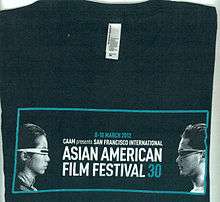Center for Asian American Media

The Center for Asian American Media (CAAM) was founded in 1980. The San Francisco-based organization, formerly known as the National Asian American Telecommunications Association (NAATA), has grown into the largest organization dedicated to the advancement of Asian Americans in independent media, specifically the areas of television and filmmaking.[1]
History
CAAM’s inception at the beginning of the 1980s came at a key moment in the historical development of Asian American media. Earlier, in 1971, Los Angeles-based activists and artists established Visual Communications (VC), a community-based organization which was instrumental in helping to create many early examples of Asian American filmmaking, including the first Asian American feature film, Robert A. Nakamura's Hito Hata: Raise the Banner in 1980. In New York, Asian CineVision (ACV) formed in 1976 and pursued similar goals as VC, helping to nurture a nascent East Coast filmmaking community.[1]
Public broadcast
With the support of the Corporation for Public Broadcasting (CPB), the Center for Asian American Media works with the national Public Broadcast Service (PBS) and its regional networks, local PBS stations, PBS series such as POV and the Independent Television Service (ITVS). Since launching the groundbreaking Asian American anthology series “Silk Screen” (1982-1987) on PBS, CAAM continues to bring award-winning works to millions of viewers nationwide.[2] CAAM is one of five minority public broadcasting consortia designated by the Corporation for Public Broadcasting (CPB) to provide programming to the Public Broadcast Service (PBS).[3] Over $3 million has flowed through CAAM's Media Fund since 1990, putting life into (or polish onto) dozens of acclaimed and award-winning projects.[4]
Film festival
Other commitments forced CAAM to shelve the festival in 1985 but beginning in 1986, CAAM took over planning, programming and management of the San Francisco International Asian American Film Festival. Since then, the SFIAAFF has since become the largest of its kind in America, with over 100 films screened over the course of 10 days and two cities (San Francisco and Berkeley). Unlike similar festivals, such as VC’s Los Angeles Asian American Film Festival, the SFIAAFF was a non-competitive showcase but starting in 2005, it created its first competitive awards for Best Asian American Feature and Best Asian American Documentary, providing a cash prize to emergent filmmakers to help support their project development.[5] In 2007, the Wallace Foundation awarded CAAM with $514,000 to use current digital media to broaden and diversify the audience for the San Francisco International Asian American Film Festival.[6]
With the expansion of the festival, CAAM announced in January 2013 the name change of the SFIAAFF to CAAMFest. The new Festival will showcase film as well as other avenues of artistic expression and community engagement, such as music, food, and interactive workshops.[7]
See also
- San Francisco International Asian American Film Festival
- Asian American theatre
- Corporation for Public Broadcasting
References
- 1 2 Oliver Wang. "CAAM History". Retrieved 2009-08-01.
- ↑ "Public Broadcast: About". Retrieved 2009-08-01.
- ↑ Allison J. Waldman. "PBS: 'P.O.V.'". Retrieved 2009-08-01.
- ↑ Jeff Yang (2007-03-13). "Asian Pop: Silver Screen". The San Francisco Chronicle. Retrieved 2009-08-01.
- ↑ "Film Festival History". Retrieved 2009-08-01.
- ↑ Jesse Hamlin (2007-03-13). "Wallace Foundation awards S.F. arts groups $7.7 million". The San Francisco Chronicle. Retrieved 2009-08-01.
- ↑ "CAAMFest". Retrieved 29 January 2013.
Further reading
- Stephen Gong, A History in Progress: Asian American Media Arts Centers 1970-1990